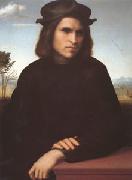
Oil On
Canvas, Real Flavor of Old Masters
|
Sandro Botticelli
|
|||
|
|
|||
| Italian Early Renaissance Painter, 1445-1510 Italian painter and draughtsman. In his lifetime he was one of the most esteemed painters in Italy, enjoying the patronage of the leading families of Florence, in particular the Medici and their banking clients. He was summoned to take part in the decoration of the Sistine Chapel in Rome, was highly commended by diplomatic agents to Ludovico Sforza in Milan and Isabella d Este in Mantua and also received enthusiastic praise from the famous mathematician Luca Pacioli and the humanist poet Ugolino Verino. By the time of his death, however, Botticelli s reputation was already waning. He was overshadowed first by the advent of what Vasari called the maniera devota, a new style by Perugino, Francesco Francia and the young Raphael, whose new and humanly affective sentiment, infused atmospheric effects and sweet colourism took Italy by storm; he was then eclipsed with the establishment immediately afterwards of the High Renaissance style, which Vasari called the modern manner, in the paintings of Michelangelo and the mature works of Raphael in the Vatican. From that time his name virtually disappeared until the reassessment of his reputation that gathered momentum in the 1890s | |||
|
|
|||
|
|
Portrait of a Man (mk05) new5/Sandro Botticelli-383829.jpg Painting ID:: 20034 Visit European Gallery |
Wood 22 1/2 x 15 1/4''(57 x 39 cm)Entered the Louvre in 1882 | |
Height Width |
INS/CM |
||
|
X |
|
||
|
|
|||
|
Giovanni Bellini
|
|||
|
|
|||
| Italian High Renaissance Painter, ca.1430-1516 (b ?1431-6; d Venice, 29 Nov 1516). Painter and draughtsman, son of (1) Jacopo Bellini. Although the professional needs of his family background may have encouraged him to specialize at an early date in devotional painting, by the 1480s he had become a leading master in all types of painting practised in 15th-century Venice. Later, towards the end of his long life, he added the new genres of mythological painting and secular allegory to his repertory of subject-matter. His increasing dominance of Venetian art led to an enormous expansion of his workshop after c. 1490; and this provided the training-ground not only for his numerous shop-hands and imitators (generically known as Belliniani) but probably also for a number of major Venetian painters of the next generation. Throughout his career, Giovanni showed an extraordinary capacity for absorbing a wide range of artistic influences, both from within Venetian tradition and from outside. He also oversaw a technical revolution in the art of painting, involving the gradual abandonment of the traditional Italian use of egg tempera in favour of the technique of oil painting pioneered in the Netherlands. It was thanks to Giovanni Bellini that the Venetian school of painting was transformed during the later 15th century from one mainly of local significance to one with an international reputation. He thus set the stage for the triumphs of Venetian painting in the 16th century and for the central contribution that Venice was to make to the history of European art. | |||
|
|
|||
|
|
Portrait of a Man (mk05) new5/Giovanni Bellini-233584.jpg Painting ID:: 20076 Visit European Gallery |
Wood 13 x 10 1/4''(33 x 26 cm)Entered the Louvre in 1902 | |
Height Width |
INS/CM |
||
|
X |
|
||
|
|
|||
|
FRANCIABIGIO
|
|||
|
|
|||
| Italian High Renaissance Painter, 1484-1525 Italian painter. The son of a Milanese linen-weaver, he had completed his apprenticeship, in Florence, by 18 October 1504. His earliest documented works, for example a Piete (1506) for S Pancrazio, Florence, have not survived. According to Vasari, Franciabigio trained with Mariotto Albertinelli, in whose last work, the signed and dated Crucifixion (1506; Florence, Certosa del Galluzzo, Pin.), he painted the angels (Shearman). In December 1508 the names of Franciabigio and Andrea del Sarto, who sometime between autumn 1506 and 1509 set up a joint workshop, were entered in the registration book of the Arte de' Medici e Speziali, to which painters were required to belong. The Portrait of a Young Man (Paris, Louvre) dates from this period. The work, which was later enlarged, shows the subject half-length, leaning pensively against a balustrade, with strong areas of shadow around the eyes. This is the first in a series of male portraits typical of Franciabigio: the subjects, each of whom wears a hat, are mostly placed in front of a landscape, with their gaze fixed meditatively or piercingly on the onlooker. The religious works from this period, such as the Virgin and Child (1509; Rome, Pal. Barberini), also show a movement away from the style of Albertinelli and Raffaellino del Garbo and begin to reveal instead the influence of Leonardo, Michelangelo and, especially, Raphael. Yet Franciabigio's connection with Andrea del Sarto was the determining factor in his career. When in 1509 it was del Sarto who received the commission to complete the fresco cycle in the atrium of SS Annunziata, Florence, their relationship altered significantly. | |||
|
|
|||
|
|
Portrait of a Man (mk05) new5/FRANCIABIGIO-545837.jpg Painting ID:: 20158 Visit European Gallery |
Wood,30 x 23 1/2''(76 x 60 cm).Acquired from the Duc de Richelieu by Louis XIV in 1665 | |
Height Width |
INS/CM |
||
|
X |
|
||
|
|
|||
|
Giovanni di
|
|||
|
|
|||
| active 1310-1347 in Siena | |||
|
|
|||
|
|
Portrait of a Man (mk05) new5/Giovanni di-278878.jpg Painting ID:: 20224 Visit European Gallery |
Canvas,37 1/2 x 30 1/4''(95 x 77 cm)Early collection | |
Height Width |
INS/CM |
||
|
X |
|
||
|
|
|||










